信息检索 英文全文数据库
- 格式:docx
- 大小:33.04 KB
- 文档页数:13

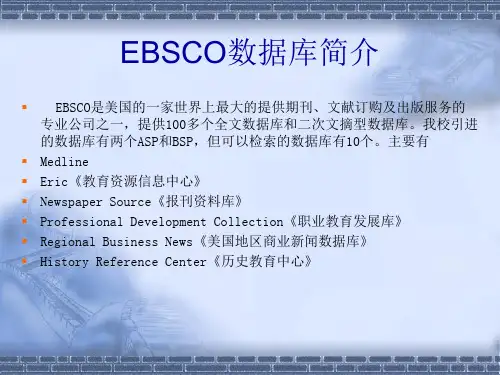
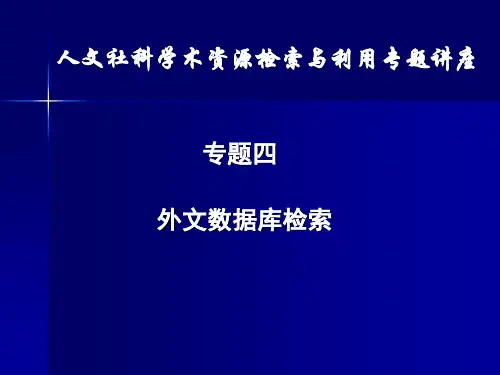

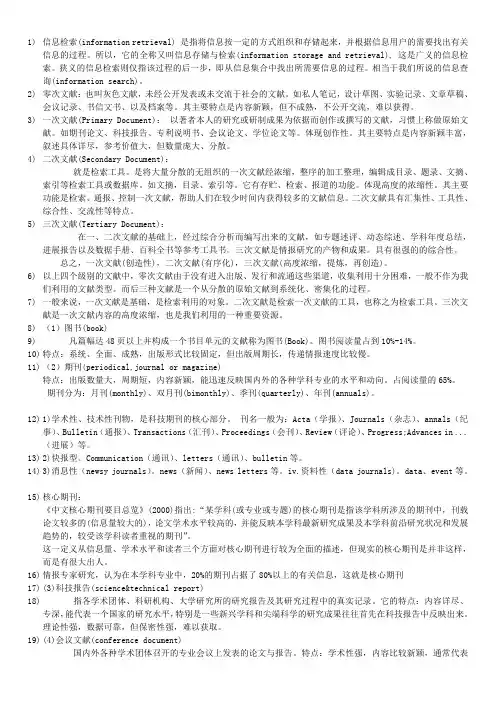
1)信息检索(information retrieval) 是指将信息按一定的方式组织和存储起来,并根据信息用户的需要找出有关信息的过程。
所以,它的全称又叫信息存储与检索(information storage and retrieval), 这是广义的信息检索。
狭义的信息检索则仅指该过程的后一步,即从信息集合中找出所需要信息的过程。
相当于我们所说的信息查询(information search)。
2)零次文献:也叫灰色文献,未经公开发表或未交流于社会的文献。
如私人笔记,设计草图、实验记录、文章草稿、会议记录、书信文书、以及档案等。
其主要特点是内容新颖,但不成熟,不公开交流,难以获得。
3)一次文献(Primary Document): 以著者本人的研究或研制成果为依据而创作或撰写的文献,习惯上称做原始文献。
如期刊论文、科技报告、专利说明书、会议论文、学位论文等。
体现创作性。
其主要特点是内容新颖丰富,叙述具体详尽,参考价值大,但数量庞大、分散。
4)二次文献(Secondary Document):就是检索工具。
是将大量分散的无组织的一次文献经浓缩,整序的加工整理,编辑成目录、题录、文摘、索引等检索工具或数据库。
如文摘,目录、索引等。
它有存贮、检索、报道的功能。
体现高度的浓缩性。
其主要功能是检索、通报、控制一次文献,帮助人们在较少时间内获得较多的文献信息。
二次文献具有汇集性、工具性、综合性、交流性等特点。
5)三次文献(Tertiary Document):在一、二次文献的基础上,经过综合分析而编写出来的文献,如专题述评、动态综述、学科年度总结,进展报告以及数据手册、百科全书等参考工具书。
三次文献是情报研究的产物和成果。
具有很强的的综合性。
总之,一次文献(创造性),二次文献(有序化),三次文献(高度浓缩,提炼,再创造)。
6)以上四个级别的文献中,零次文献由于没有进入出版、发行和流通这些渠道,收集利用十分困难,一般不作为我们利用的文献类型。
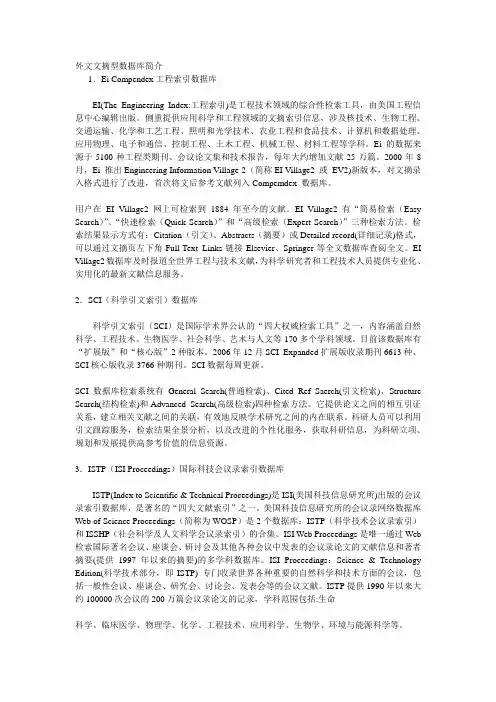
外文文摘型数据库简介1.Ei Compendex工程索引数据库EI(The Engineering Index:工程索引)是工程技术领域的综合性检索工具,由美国工程信息中心编辑出版。
侧重提供应用科学和工程领域的文摘索引信息,涉及核技术、生物工程、交通运输、化学和工艺工程、照明和光学技术、农业工程和食品技术、计算机和数据处理、应用物理、电子和通信、控制工程、土木工程、机械工程、材料工程等学科。
Ei的数据来源于5100种工程类期刊、会议论文集和技术报告,每年大约增加文献25万篇。
2000年8月,Ei 推出Engineering Information Village-2(简称EI Village2 或EV2)新版本,对文摘录入格式进行了改进,首次将文后参考文献列入Compemdex 数据库。
用户在EI Village2网上可检索到1884年至今的文献。
EI Village2有“简易检索(Easy Search)”、“快速检索(Quick Search)”和“高级检索(Expert Search)”三种检索方法。
检索结果显示方式有:Citation(引文)、Abstracts(摘要)或Detailed record(详细记录)格式,可以通过文摘页左下角Full-Text Links链接Elsevier、Springer等全文数据库查阅全文。
EI Village2数据库及时报道全世界工程与技术文献,为科学研究者和工程技术人员提供专业化、实用化的最新文献信息服务。
2.SCI(科学引文索引)数据库科学引文索引(SCI)是国际学术界公认的“四大权威检索工具”之一,内容涵盖自然科学、工程技术、生物医学、社会科学、艺术与人文等170多个学科领域。
目前该数据库有“扩展版”和“核心版”2种版本。
2006年12月SCI Expanded扩展版收录期刊6613种、SCI核心版收录3766种期刊。
SCI数据每周更新。
SCI数据库检索系统有General Search(普通检索)、Cited Ref Saerch(引文检索)、Structure Search(结构检索)和Advanced Search(高级检索)四种检索方法。
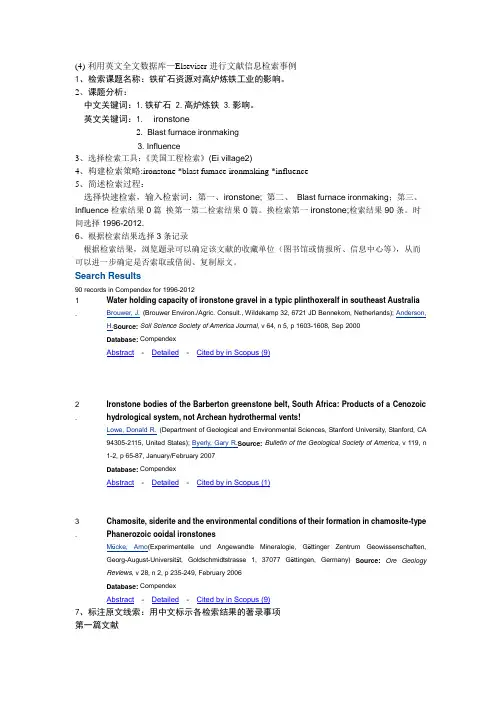
(4)利用英文全文数据库—Elseviser进行文献信息检索事例1、检索课题名称:铁矿石资源对高炉炼铁工业的影响。
2、课题分析:中文关键词:1.铁矿石 2.高炉炼铁 3.影响。
英文关键词:1.ironstone2. Blast furnace ironmaking3. Influence3、选择检索工具:《美国工程检索》(Ei village2)4、构建检索策略:ironstone *blast fumace ironmaking *influence5、简述检索过程:选择快速检索,输入检索词:第一、ironstone; 第二、Blast furnace ironmaking;第三、Influence检索结果0篇换第一第二检索结果0篇。
换检索第一ironstone;检索结果90条。
时间选择1996-2012.6、根据检索结果选择3条记录根据检索结果,浏览题录可以确定该文献的收藏单位(图书馆或情报所、信息中心等),从而可以进一步确定是否索取或借阅、复制原文。
Search Results90 records in Compendex for 1996-20121 .Water holding capacity of ironstone gravel in a typic plinthoxeralf in southeast Australia Brouwer, J.(Brouwer Environ./Agric. Consult., Wildekamp 32, 6721 JD Bennekom, Netherlands); Anderson, H.Source:Soil Science Society of America Journal, v 64, n 5, p 1603-1608, Sep 2000Database: CompendexAbstract- Detailed- Cited by in Scopus (9)2 .Ironstone bodies of the Barberton greenstone belt, South Africa: Products of a Cenozoic hydrological system, not Archean hydrothermal vents!Lowe, Donald R.(Department of Geological and Environmental Sciences, Stanford University, Stanford, CA 94305-2115, United States); Byerly, Gary R.Source:Bulletin of the Geological Society of America, v 119, n 1-2, p 65-87, January/February 2007Database: CompendexAbstract- Detailed- Cited by in Scopus (1)3 .Chamosite, siderite and the environmental conditions of their formation in chamosite-type Phanerozoic ooidal ironstonesMücke, Arno(Experimentelle und Angewandte Mineralogie, Göttinger Zentrum Geowissenschaften, Georg-August-Universität, Goldschmidtstrasse 1, 37077 Göttingen, Germany) Source:Ore Geology Reviews, v 28, n 2, p 235-249, February 2006Database: CompendexAbstract- Detailed- Cited by in Scopus (9)7、标注原文线索:用中文标示各检索结果的著录事项第一篇文献。

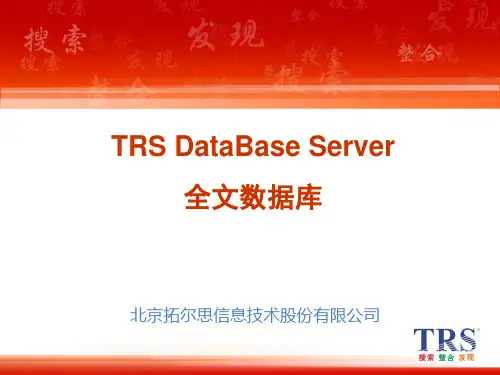
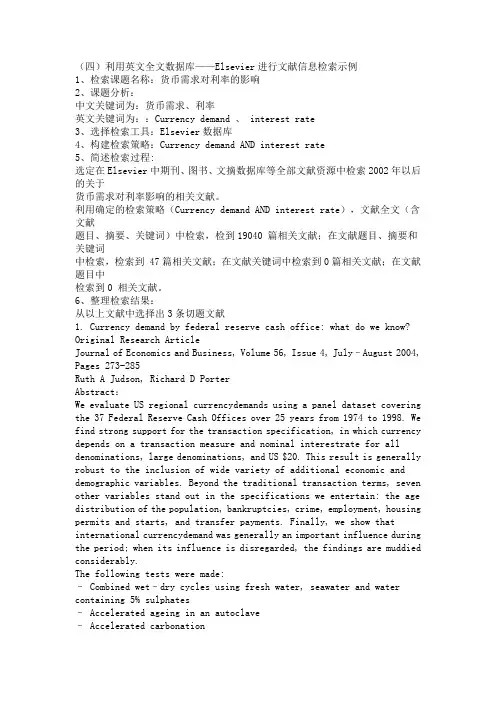
(四)利用英文全文数据库——Elsevier进行文献信息检索示例1、检索课题名称:货币需求对利率的影响2、课题分析:中文关键词为:货币需求、利率英文关键词为::Currency demand 、 interest rate3、选择检索工具:Elsevier数据库4、构建检索策略:Currency demand AND interest rate5、简述检索过程:选定在Elsevier中期刊、图书、文摘数据库等全部文献资源中检索2002年以后的关于货币需求对利率影响的相关文献。
利用确定的检索策略(Currency demand AND interest rate),文献全文(含文献题目、摘要、关键词)中检索,检到19040 篇相关文献;在文献题目、摘要和关键词中检索,检索到 47篇相关文献;在文献关键词中检索到0篇相关文献;在文献题目中检索到0 相关文献。
6、整理检索结果:从以上文献中选择出3条切题文献1. Currency demand by federal reserve cash office: what do we know? Original Research ArticleJournal of Economics and Business, Volume 56, Issue 4, July–August 2004, Pages 273-285Ruth A Judson, Richard D PorterAbstract:We evaluate US regional currencydemands using a panel dataset covering the 37 Federal Reserve Cash Offices over 25 years from 1974 to 1998. We find strong support for the transaction specification, in which currency depends on a transaction measure and nominal interestrate for all denominations, large denominations, and US $20. This result is generally robust to the inclusion of wide variety of additional economic and demographic variables. Beyond the traditional transaction terms, seven other variables stand out in the specifications we entertain: the age distribution of the population, bankruptcies, crime, employment, housing permits and starts, and transfer payments. Finally, we show that international currencydemand was generally an important influence during the period; when its influence is disregarded, the findings are muddied considerably.The following tests were made:– Combined wet–dry cycles using fresh water, seawater and water containing 5% sulphates– Accelerated ageing in an autoclave– Accelerated carbonationThe performance of the concrete containing sludge was acceptable and comparable to the results obtained for the reference concrete not containing sludge.Keywords: Currency; Domestic; International; Money demand; Panel2. Black market exchange rate, currency substitution and the demand for money in LDCs Original Research ArticleEconomic Systems, Volume 30, Issue 3, October 2006, Pages 249-263 Mohsen Bahmani-Oskooee, Altin TankuAbstract:Mundell's conjecture in 1963 that the demand for money could depend on the exchange rate in addition to income and interestrate has received some attention in the literature by including the official exchange rate and estimating the money demand in a few developed countries. In less developed countries, since there is a black market for foreign exchange, it has been suggested that the black market exchange rate rather than the official rate should be the determinant of the demand for money in LDCs. This proposition is tested by estimating the demand for money for 25 LDCs using the bounds testing approach to cointegration. The main conclusion is that while in some LDCs, the black market rate enters into the formulation of the demand for money, in some others the official rate is the determinant. The black market premium also played a role in some countries.JEL classification• E41;• F31Keywords: Money demand; Black market exchange rate; Bounds testing3. An oil demand and supply model incorporating monetary policy Original Research ArticleEnergy, Volume 35, Issue 5, May 2010, Pages 2013-2021Hossein Askari, Noureddine KricheneAbstract:Oil price inflation may have had a significant role in pushing the world economy into its worst post-war recession during 2008–2009. Reserve currency central banks pursued an overly expansionary monetary policy during 2001–2009, in the form of low or negative real interestrates and accompanied by a rapidly falling US dollar, while paying inadequate attention to the destabilizing effects on oil markets. In this paper, we show that monetary policy variables, namely key interestrates and the US dollar exchange rate, had a powerful effect on oil markets. World oil demand was significantly influenced by interest and dollar exchangerates, while oil supply was rigid. Oil demand and supply have very low price elasticity and this characteristic makes oil prices highly volatile and subject to wider fluctuations than the prices of other commodities. Aggressive monetary policy would stimulate oil demand, however, it would be met with rigid oil supply and would turn inflationary and disruptive to economic growth if there was little excess capacity in oil output. We argue that a measure of stability in oil markets cannot be achieved unless monetary policy is restrained and real interestrates become significantly positive. Monetary tightening during 1979–1982 might implythat monetary policy has to be restrained for a long period and with high interestrates in order to bring stability back to oil markets. Keywords:Crude oil; Demand and supply; Elasticity; Exchange rate; Interestrates6、全文摘录选择一篇:1An oil demand and supply model incorporating monetary policy一、篇名An oil demand and supply model incorporating monetary policy二、著者Hossein Askari,Noureddine Krichene三、著者机构George Washington University, 17795 Canby Road, Leesburg, VA 20175, USA International Monetary Fund, 700 19th Street, NW, Washington DC 20431, USAReceived 1 October 2009. Accepted 15 January 2010. Available online 3 March 2010./10.1016/j.energy.2010.01.017, How to Cite or Link UsingDOI四、文摘 AbstractOil price inflation may have had a significant role in pushing the world economy into its worst post-war recession during 2008–2009. Reserve currency central banks pursued an overly expansionary monetary policy during 2001–2009, in the form of low or negative real interestrates and accompanied by a rapidly falling US dollar, while paying inadequate attention to the destabilizing effects on oil markets. In this paper, we show that monetary policy variables, namely key interestrates and the US dollar exchange rate, had a powerful effect on oil markets. World oil demand was significantly influenced by interest and dollar exchange rates, while oil supply was rigid. Oil demand and supply have very low price elasticity and this characteristic makes oil prices highly volatile and subject to wider fluctuations than the prices of other commodities. Aggressive monetary policy would stimulate oil demand, however, it wouldbe met with rigid oil supply and would turn inflationary and disruptive to economic growth if there was little excess capacity in oil output. We argue that a measure of stability in oil markets cannot be achieved unless monetary policy is restrained and real interestrates become significantly positive. Monetary tightening during 1979–1982 might implythat monetary policy has to be restrained for a long period and with high interestrates in order to bring stability back to oil markets.五、关键词 Keywords:Crude oil; Demand and supply; Elasticity; Exchange rate; Interestrates六、正文1. Introduction(首段)The world economy experienced its worst post-WWII recession during 2008–2009 as oil prices raced from $20/barrel in 2001 to over $147/barrel in July 2008.1 Left unchecked and largely ignored by reserve currency central bankers, high fuel prices diverted large quantities of grains to the production of ethanol, putting pressure on corn and soybean markets; disrupted agriculture, airlines, auto industry; set off food riots in vulnerable countries; led to oil protests in major industrial countries; and aggravated poverty and unemployment around the world.(末段)During 2001–2008, major reserve currency central banks followed a highly expansionary monetary policy that ignited rapid commodity price inflation. Food and oil prices rose at unprecedented pace and reached levels that triggered riots and protests. Such a policy disrupted vital food and energy markets, and was a factoring the ensuing economic recession and high unemployment. In response to the recession during 2008–2009, reserve central banks decided to keep key money market rates near zero bounds and to expand the supply of money. This policy could encourage more speculation in commodity markets, especially in markets that face rigid demand and supply, such as oil. The data for 1976–1986 shows that monetary policy may have to be tightened significantly in order to reduce commodity price inflation and that money market interest rates, such as the LIBOR or the federal funds rate, may have to be maintained on average at levels similar to those during 1986–2001 in order to restore long-term stability in oil markets. Based on monetary tightening during 1979–1982, the period of monetary restraint may have to be extended over many years and interest rates may have to rise significantly before long-term oil market stability can be restored.七、参考文献 References1.[1]J.D. HamiltonOil and the macroeconomy since world war IIJournal of Political Economy, 91 (2) (1983), pp. 228–248View Record in Scopus|Full Text via CrossRef| Cited By in Scopus (288)2.[2]J.D. HamiltonWhat is an oil shockJournal of Econometrics, 113 (2) (2003), pp. 363–398Article | PDF (481 K) |View Record in Scopus|Full Text via CrossRef| Cited By in Scopus (223)3.[3]N.S. Balke, S.P.A. Brown, M. YucelOil price shocks and the U.S. economy: where does the asymmetry originate?The Energy Journal, 3 (2002), pp. 27–52View Record in Scopus|Full Text via CrossRef| Cited By in Scopus (48)4.[4]D.W. Jones, P.N. Leiby, I.K. PaikOil price shocks and the macroeconomy: what have we learned since 1996?The Energy Journal, 2 (2004), pp. 1–32View Record in Scopus|Full Text via CrossRef| Cited By in Scopus (82)5.[5]B.S. Bernanke, M. Gertler, M. WatsonSystematic monetary policy and the effects of oil shocksBrookings Papers on Economic Activity, 1 (1997), pp. 91–157View Record in Scopus|Full Text via CrossRef| Cited By in Scopus (156)6.[6]J.J. Rotemberg, M. WoodfordImperfect competition and the effects of energy price increases on the economic activityJournal of Money, Credit and Banking, 28 (1996), pp. 549–577Full Text via CrossRef7.[7]H. ThorntonF.R.A.v. Hayek (Ed.), An inquiry into the nature and effects of the paper credit of Great Britain, Rinehart, New York (1802) 19398.[8]D. RicardoOn the principles of political economy and taxationJohn Muray, London, UK (1817)9.[9]Tooke, T, The history of prices. 1838.10.[10]K. WicksellInterest and pricesMacMillan and Co, London, UK (1898)11.[11]J.M. KeynesThe general theory of employment, interest and moneyMacmillan (reprinted 2007), London, UK (1936)12.[12]M. FriedmanA program for monetary stabilityFordham University Press, New York, NY (1959)13.[13]B. McCallum, W. NelsonPerformance of operational policy rules in an estimated semi- classical structural modelJohn Taylor (Ed.), Monetary policy rules, University of Chicago Press, Chicago, IL (2000), pp. 15–4514.[14]J. WilliamsonThe open economy and the world economyBasic Books, New York, NY (1983)15.[15]E.W. Erickson, R.M. SpannSupply response in a regulated industry: the case of natural gasThe Bell Journal of Economics and Management Science, 1 (1971), pp. 94–121Full Text via CrossRef16.[16]J.H. EyssellThe supply response of crude petroleum – new and optimistic resultsBusiness Economics, 13 (3) (1978), pp. 338–34617.[17]R.S. PindyckThe structure of world energy demandMIT Press, Cambridge, MA (1979)18.[18]M.H. Pesaran, R.P. Smith, T. AkiyamaEnergy demand in Asian developing economiesOxford University Press/World Bank, New York, NY (1998)19.[19]D. Gately, H.G. HuntingtonThe asymmetric effects of changes in price and income on energy and oil demandThe Energy Journal, 1 (2002), pp. 19–55View Record in Scopus|Full Text via CrossRef| Cited By in Scopus (42)20.[20]J. Griffin, G. SchulmanPrice asymmetry in energy demand models: a proxy for energy- saving technical change?The Energy Journal, 2 (2005), pp. 1–21View Record in Scopus|Full Text via CrossRef| Cited By in Scopus (17)21.[21]F.M. FisherSupply costs in the United States petroleum industryJohn Hopkins University Press, Baltimore, MD (1964)22.[22]C. Dhal, T.E. DugganSurvey of price elasticities from economic exploration models of US oil and gas supplyJournal Energy Finance and Development, 2 (1998), pp. 129–16923.[23]K. Lee, S. Ni, R.A. RattiOil shocks and the macroeconomy: the role of price variabilityThe Energy Journal, 4 (1995), pp. 39–56View Record in Scopus|Full Text via CrossRef| Cited By in Scopus (165)24.[24]B.S. Bernanke, A.S. Blinder"The federal funds rate and the channels of monetary transmissionsAmerican Economic Review, 4 (1992), pp. 901–921View Record in Scopus。
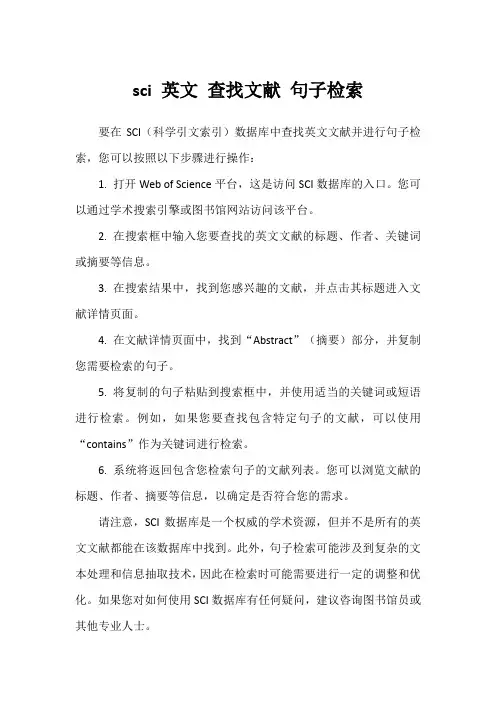
sci 英文查找文献句子检索要在SCI(科学引文索引)数据库中查找英文文献并进行句子检索,您可以按照以下步骤进行操作:
1. 打开Web of Science平台,这是访问SCI数据库的入口。
您可以通过学术搜索引擎或图书馆网站访问该平台。
2. 在搜索框中输入您要查找的英文文献的标题、作者、关键词或摘要等信息。
3. 在搜索结果中,找到您感兴趣的文献,并点击其标题进入文献详情页面。
4. 在文献详情页面中,找到“Abstract”(摘要)部分,并复制您需要检索的句子。
5. 将复制的句子粘贴到搜索框中,并使用适当的关键词或短语进行检索。
例如,如果您要查找包含特定句子的文献,可以使用“contains”作为关键词进行检索。
6. 系统将返回包含您检索句子的文献列表。
您可以浏览文献的标题、作者、摘要等信息,以确定是否符合您的需求。
请注意,SCI数据库是一个权威的学术资源,但并不是所有的英文文献都能在该数据库中找到。
此外,句子检索可能涉及到复杂的文本处理和信息抽取技术,因此在检索时可能需要进行一定的调整和优化。
如果您对如何使用SCI数据库有任何疑问,建议咨询图书馆员或其他专业人士。
Springer具体学科涉及:数学、物理与天文学、化学、生命科学、医学、工程学、计算机科学、环境科学、地球科学、经济学、法律。
右上部可以选择界面的语言实例1检索关于“乙醇的分离”方面的文献。
检索课题分析:从题目字面上看,检索式“乙醇and 分离”是正确的,但在化学化工上,将混合物分离(separation)的目的是为了提纯,因此加上提纯和纯化(purification,refine),检索策略就更全了。
所以我们将其检索式定为“(alcohol or ethanol)and (separ* or purific* or refin*)”,检索步骤如下图所示:在标题字段输入(alcohol or ethanol)and (separ* or purific* or refin*),在高级检索中输入检索式,如图所示。
检索关于“乙醇的分离”方面的文献。
检索课题分析:从题目字面上看,检索式“乙醇and 分离”是正确的,但在化学化工上,将混合物分离(separation)的目的是为了提纯,因此加上提纯和纯化(purification,refine),检索策略就更全了。
所以我们将其检索式定为“(alcohol or ethanol)and (separ* or purific* or refin*)”,检索步骤如下图所示:在标题字段输入(alcohol or ethanol)and (separ* or purific* or refin*),在高级检索中输入检索式。
EBSCO在线文献数据库,涉及自然科学、社会科学、人文和艺术等多种学术领域。
主要的数据库有:1、Academic Source Premier2、Business Source Premier3、Communication & Mass Media Complete4、EconLit5、PsycARTICLES如要跨库检索,可在页面上点击“选择数据库”标签,进入选库界面,复选后重新进入检索。
利用英文全文数据库——Elsevier 进行文献信息检索示例1、检索课题名称:海洋光学遥测信息应用研究2、课题分析:中文关键词:1海洋光学2遥测英文关键词: 1 Ocean optics 2 Telemetering3、选择检索工具:《美国工程索引》(Ei village)4、构建检索策略:(Telemetering)* Ocean optics5、检索过程:选定在Elsevier 中期刊、图书、文摘数据库等全部文献资源中检索所有年份的海洋光学遥测的相关文献总共找到44篇的相关文献。
6、整理检索结果:从以上文献中选择出3条切题文献1、Emerging ocean observations for interdisciplinary data assimilation systems Original Research ArticleJournal of Marine Systems, Volumes 40–41, April 2003, Pages 5-48AbstractIdentification, understanding, and prediction of many interdisciplinary oceanographic processes remain as elusive goals of ocean science. However, new ocean technologies are being effectively used to increase the variety and numbers of sampled variables and thus to fill in the gaps of the time-space continuum of interdisciplinary ocean observations. The formulation, accuracy, and efficacy of data assimilative models are highly dependent upon the quality and quantity of interdisciplinary observational data. In turn, the design of optimal sampling networks will benefit from data assimilative-based observation system simulation experiments (OSSEs). The present contribution, which is directed toward both modelers and observationalists, reviews emerging interdisciplinary observational capabilities and their optimal utilization in data assimilative models.2、The evolution of the instrumental technique in underwater optics Original Research ArticleProgress In Oceanography, Volume 3, 1963, Pages 149-154Nils JerlovAbstractAbstract | ReferencesReferencesAbstractThanks to the use of the photovoltaic cell significant pioneer work in underwater optics was made in the 1930's. Among the principal instruments designed at that time, the beam transmittance meter and the scatterance meter were introduced in oceanographic studies by Hans Pettersson. The development of a technique with photomultiplier tubes provided a new impetus in optical research particularly in the study of scattering problems. A distinct advantage with photomultiplier tubes is that their high sensitivity makes possible the use of interference filters by which almost monochromatic measurements are obtained and the treacherous “band width error” occurring with broad filters is avoided.An equipment of in situ instruments fit for routine observations is described, namely an irradiance meter, a beam transmittance meter and a scatterance meter which measure the spectral energy distribution, the total attenuation coefficient and the total scattering coefficient respectively. The meters are provided with simple depth sensing units and records are obtained with an x−y recorder.It is emphasized that the optical parameters contribute greatly to the description and characterization of water masses3、t is emphasized that the optical parameters contribute greatly to the description and characterization of water massesReal-time remote monitoring of water quality: a review of current applications, and advancements in sensor, telemetry, and computing technologies Original Research ArticleJournal of Experimental Marine Biology and Ecology, Volume 300, Issues 1–2, 31 March 2004, Pages 409-448Howard B Glasgow, JoAnn M Burkholder, Robert E Reed, Alan J Lewitus, Joseph E KleinmanAbstractAbstract | Figures/TablesFigures/Tables | ReferencesReferencesAbstractRecent advances in communication and sensor technology have catalyzed progress in remote monitoring capabilities for water quality. As a result, the ability to characterize dynamic hydrologic properties at adequate temporal and spatial scales has greatly improved. These advances have led to improved statistical and mechanistic modeling in monitoring of water quality trends at local, watershed and regional scales for freshwater, estuarine and marine ecosystems. In addition, they have greatly enhanced rapid (e.g.,real-time) detection of hydrologic variability, recognized as a critical need for early warning systems and rapid response to harmful algal bloom events. Here, we present some of the landmark developments and technological achievements that led to the advent of real-time remote monitors for hydrologic properties. We conclude that increased use and continuing advancements of real-time remote monitoring (RTRM) and sensing technologies will become a progressively more important tool for evaluating water quality. Recent engineering and deployment of RTRM technologies by federal and state regulatory agencies, industries, and academic laboratories is now permitting rapid detection of, and responses to, environmental threats imposed by increased nutrient loadings, development of hypoxic and anoxic areas, toxicants, and harmful algal bloom outbreaks leading to fish kill events and potential human health impacts.6、全文摘录选择一篇:1. Real-time remote monitoring of water quality: a review of current applications, and advancements in sensor, telemetry, and computing technologies一、篇名Real-time remote monitoring of water quality: a review of current applications, and advancements in sensor, telemetry, and computing technologies二、著者Howard B. Glasgowa,*, JoAnn M. Burkholdera,Robert E. Reeda, Alan J. Lewitusb,c, Joseph E. Kleinmana三、著者机构 a Center for Applied Aquatic Ecology, North Carolina State University, 620 Hutton Street,Raleigh, NC 27606, USAb Belle W. Baruch Institute of Marine and Coastal Sciences, University of SouthBaruch Marine Laboratory, Georgetown, SC 29442, USAc Marine Resources Research Institute, South Carolina Department of Natural Resources,Hollings Marine Laboratory, Charleston, SC 29412, USA四、文摘AbstractRecent advances in communication and sensor technology have catalyzed progress in remote monitoring capabilities for water quality. As a result, the ability to characterize dynamic hydrologic properties at adequate temporal and spatial scales has greatly improved. These advances have led to improved statistical and m e c h a n i s t i c m o d e l i n g i n m o n i t o r i n g o f w a t e r quality trends at local, watershed and regional scales for freshwater, estuarine and marine ecosystems. In addition, they have greatly enhanced rapid (e.g., real-time) detection of hydrologic variability, recognized as a critical need for early warning systems and rapid responseto harmful algal bloom events. Here, we present some of the landmark developments andtechnological achievements that led to the advent of real-time remote monitors for hydrologicproperties. We conclude that increased use and continuing advancements of real-time remotemonitoring (RTRM) and sensing technologies will become a progressively more important toolfor evaluating water quality. Recent engineering and deployment of RTRM technologies byfederal and state regulatory agencies, industries, and academic laboratories is now permittingrapid detection of, and responses to, environmental threats imposed by increased nutrientloadings, development of hypoxic and anoxic areas, toxicants, and harmful algal bloomoutbreaks leading to fish kill events and potential human health impacts五、关键字Keywords: Communications; Harmful algal blooms; Real-time remote monitoring; Sensor technology; Telemetry;Water quality六、正文1. IntroductionAs water quality perturbations related to escalating human population growth andindustry pressures continue to increase in coastal and inland areas (Caraco, 1995; NationalResearch Council, 2000; World Resources Institute, 2003), effective water qualitymonitoring has become critical for water resource management programs.accurate, intensive and long-term data acquisition, the state of the world’s water resourcescannot be adequately assessed, effective preservation and remediation programs cannot berun, and program success cannot be properly evaluated. For decades, field measurementsfor water quality evaluation have depended upon costly, time- andlabor-intensive on-sitesampling and data collection, and transport to land-based or shipboard laboratories forevaluation. While these research and monitoring efforts are episodically intensive, theygenerally have been too limited on temporal and spatial scales to adequately addressfactors influencing development of events such as harmful algal blooms, oxygen depletion, fish kills, and contamination of shellfish beds by enteric bacteria. In addition,data utility may be compromised due to inadequate quality-control and quality-assuranceprotocols such as extended holding times before analysis and use ofnon-standardizedmethodologies, and the data are frequently susceptible to recording andgeo-referencingerrors during transcription末段In the near future, application of molecular based biosensors fielded on autonomousplatforms will likely be tightly integrated with, and to some extent controlled by, otherphysical–chemical sensors. The latter sensors would trigger a molecular analytical eventin response to a hierarchical set of environmental variables readily detectable at highfrequency, and previously identified as indicators of conditions favorable for HABformation. Despite the challenges that lie ahead, the development of sensors based onmolecular biological techniques is progressing rapidly and holds great promise forapplication on autonomous platforms.摘要American Heritage Rivers, 2003. State of the River Report-Upper Susquehanna-Lackawanna. PennsylvaniaProgram Office, U.S. EPA, Annapolis, MD, 4 pp.American Society for Testing and Materials (ASTM), 1995. Standard Guide for Ventilatory Behavioral ToxicologyTesting of Freshwater Fish, E 1768–95. American Society for Testing and Materials, West Conshohocken,PA, pp. 1 – 10.Anderson, D.M., 1995. Identification of harmful algal species using molecular probes, an emerging perspective.In: Lassus, P., Arzul, G., Erard, E., Gentien, P., Marcaillou, C. (Eds.), Harmful Marine Algae. Technique etDocumentation-Lavoisier/Intercept, Paris, pp. 3 – 13.Bissett, W.P., Schofield, O., Glenn, S., Cullen, J.J., Miller, W.L., Plueddemann, A.J., Mobley, C.D., 2001.Resolving the impacts and feedbacks of ocean optics on upper ocean ecology. Oceanography 14, 30–49.Bolch, C.J.S., 2001. PCR protocols for genetic identification of dinoflagellates directly from single cysts andplankton cells. Phycologia 40, 162– 167.Bowers, H.A., Tengs, T., Glasgow, H.B., Burkholder, J.M., Rublee, P.A., Oldach, D.W., 2000. Development ofreal-time PCR assays for rapid detection of Pfiesteria piscicida and related dinoflagellates. Appl. Environ.Microbiol. 66, 4641–4648.Burkholder, J.M., 1998. Implications of harmful marine microalgae and heterotrophic dinoflagellates in managementof sustainable marine fisheries. Ecol. Appl. 8, S37– S62.Burkholder, J.M., 2000. Critical needs in harmful algal bloom research. National Research Council, Opportunitiesfor Environmental Applications of Marine Biotechnology. National Academy of Sciences Press,pp. 126–149.Burkholder, J.M., Glasgow, H.B., 1999. Neuse Estuary Biomonitoring Study, with Additional Information onOverall Nutrient Loading to the Mesohaline Estuary. Report to the U.S. Marine Corps Air Station—CherryPoint. CAAE, NCSU, Raleigh, NC, pp. 1 – 134.Burton, D.T., Tieman, D.M., 1996. Evaluation of Bio-monitoring Systems for Assessment of ContaminatedWater and Sediments at U.S. Army Installations. Annual Report # AD-A319417, U.S. Army Center ForEnvironmental Health Research, Fort Detrick, MD.Campanella, L., Cubadda, F., Sammartino, M.P., Saoncella, A., 2001. An algal biosensor for the monitoring ofwater toxicity in estuarine environments. Water Res. 35, 69–76.Caraco, N.F., 1995. Influence of human populations on P transfers to aquatic systems: a regional scale studyusing large rivers. In: Tiessen, H. (Ed.), Phosphorus in the Global Environment. SCOPE 54. Wiley, NewYork, pp. 235–247.Chesapeake Bay Program, 1983. Chesapeake Bay Agreement of 1983. Chesapeake Bay Program Office, U.S.EPA, Annapolis, MD. 1 p.Coyne, K.J., Hutchins, D.A., Hare, C.E., Cary, S.C., 2001. Assessing temporal and spatial variability in Pfiesteriapiscicida distributions using molecular probing techniques. Aquat. Microb. Ecol. 24, 275– 285.Degenhardt-Langelaan, C.E.A.M., Kientz, C.E., 1996. Capillary gas chromatography analysis of nerve agentsusing large volume injections. J. Chromatogr., A 723, 210– 214.Deines, K.L., 1999. Backscatter estimation using broadband acoustic Doppler current profilers. Oceans99 MTS/IEEE Conference Proceedings, 13 – 16 September. The Institute of Electrical and Electronics Engineers,Piscataway, NJ.Dyble, J., Paerl, H.W., Neilan, B.A., 2002. Genetic characterization of Cylindrospermopsis raciborskii (Cyanobacteria)isolates from diverse geographic origins based on nifH and cpcBA-IGS nucleotide sequence analysis.Appl. Environ. Microbiol. 68, 2567–2571.Franks, P.J.S., Anderson, D.M., 1992a. Alongshore transport of a toxic phytoplankton bloom in a buoyancycurrent: Alexandrium tamarense in the Gulf of Maine. Mar. Biol. 112, 153– 164.Franks, P.J.S., Anderson, D.M., 1992b. Toxic phytoplankton blooms in the southwestern Gulf of Maine: testinghypotheses of physical control using historical data. Mar. Biol. 112, 165– 174.Frense, D., Mu¨ ller, A., Beckmann, D., 1998. Detection of environmental pollutants using optical biosensor withimmobilized algae cells. Sens. Actuators, B 51, 256–260.Gentien, P., Lunven, M., Le Haıˆtre, M., Duvent, J.L., 1995. In situ depth profiling of particle sizes. Deep Sea Res.42, 1297– 1312.H.B. Glasgow et al. / J. Exp. Mar. Biol. Ecol. 300 (2004) 409–448 445Glasgow, H.B., Burkholder, J.M., 2000. Water quality trends and management implications from a five-yearstudy of a eutrophic estuary. Ecol. Appl. 10, 1024– 1046.Glasgow, H.B., Burkholder, J.M., Mallin, M.A., Deamer-Melia, N.J., Reed, R.E., 2001. Field ecology of toxicPfiesteria complex species, and a conservative analysis of their role in estuarinefish kills. Environ. HealthPerspect. 109, 715– 730.Godhe, A., Otta, S.K., Rehnstam-Holm, A.-S., Karunasagar, I., Karunasagar, D.I., 2001. Polymerase chainreaction in detection of Gymnodinium mikimotoi and Alexandrium minutum in field samples from southwestIndia. Mar. Biotechnol. 3, 152–162.Greenberg, B.M., Hull, R.N., Roberts, M.H., Gensemer, R.W. (Eds.), 2001. American Society for Testing andMaterials (ASTM) 2001. Environmental Toxicology and Risk Assessment: Science, Policy, and Standardization—Implications for Environmental Decisions, 10th Volume. American Society for Testing and Materials(ASTM), West Conshohocken, PA, pp. 1– 363.Hall, S., 1999. Volunteer phytoplankton program. In: Martin, J.L., Haya, K. (Eds.), Proceedings of theSixth Canadian Workshop on Harmful Marine Algae. Can. Tech. Rep. Fish. Aquat. Sci. No.2261, pp.1– 30.Hoagland, P., Anderson, D.M., Kaoru, Y., White, A.W., 2002. The economic effects of harmful algal blooms inthe United States: estimates, assessment issues, and information needs. Estuaries 25, 819–837.IEEE, A.W., 2003. IEEE Standards Association Operations Manual. IEEE, New York, (last accessed in April 2004).Innis, M.A., Gelfand, D.H., Sninsky, J.J. (Eds.), 1995. PCR Strategies. Academic Press, San Diego, CA, pp. 1 – 373.Integral Systems, J.J., 1991. The Data Collection System Automatic Processing System (DAPS) and DomesticSatellite (DOMSAT) Receive-Only Terminal (DROT) User Interface Manual, Version 3.0. Report # ISI-52-102. NOAA, Lanham, MD, pp. 1 –45.Jones, R.J., Hoegh-Guldberg, O., 1999. Effects of cyanide on coral photosynthesis: implications for identifyingthe cause of coral bleaching and for assessing the environmental effects of cyanide fishing. Mar. Ecol., Prog.Ser. 177, 83– 91.Kearns, E.J., Hanafin, J.A., Evans, R.H., Minnett, P.J., Brown, O.B., 2000. An independent assessment ofpathfinder AVHRR sea surface temperature accuracy using the marine atmosphere emitted radiance interferometer(MAERI). Bull. Am. Meteorol. Soc. 81, 1525– 1536.Khordagui, K., 1995. Fate and control of nerve chemical warfare agents in the desalination industry of theArabian– Persian Gulf. Environ. Int. 21, 363– 379.Kirkpatrick, G.J., Millie, D.F., Moline, M.A., Schofield, O.M., 2000. Optical discrimination of a phytoplanktonspecies in natural mixed populations. Limnol. Oceanogr. 45, 467– 471.Kirkpatrick, G.J., Orrico, C., Moline, M.A., Oliver, M., Schofield, O.M., 2003. Continuous hyperspectralabsorption measurements of colored dissolved organic material in aquatic systems. Appl. Opt. 42,6564–6568.Koblizek, M., Masojidek, J., Komenda, J., Kucera, J., Pilloton, R., Mattoo, A.K., Giardi, M.T., 1998. A sensitivephotosystem II-based biosensor for detection of a class of herbicides. Biotechnol. Bioeng. 60, 664–669.Lakso, H.-A., Ng, W.F., 1997. Determination of chemical warfare agents in natural water samples by solid-phasemicroextraction. Anal. Chem. 69, 1866–1872.Langebrake, L.C., 2003. AUV sensors for marine research. In: Griffiths, G. (Ed.), Technology and Applicationsof Autonomous Underwater Vehicles. Taylor and Francis, London, pp. 245–277.Lewitus, A.J., Schmidt, L.B., Mason, L.J., Kempton, J.W., Wilde, S.B., Wolny, J.L., Williams, B.J., Hayes, K.C.,Hymel, S.N., Keppler, C.J., Ringwood, A.H., 2003. Harmful algal blooms in South Carolina residential andgolf course ponds. Pop. Environ. 24, 387–413.Mallat, E., Barzen, C., Abuknesha, R., Gauglitz, G., Barcelo, D., 2001. Fast determination of paraquat residues inwater by an optical immunosensor and validation using capillary electrophoresis-ultraviolet detection. Anal.Chim. Acta 427, 165– 171.Mallin, M.A., Burkholder, J.M., Cahoon, L.B., Posey, M.H., 2000. North and South Carolina coasts. Mar. Pollut.Bull. 41, 56–75.Maryland Department of Natural Resources [MD DNR], M.H., 2000. Associations Between Pfiesteria, FishHealth, and Environmental Conditions in Maryland. Tidewater Ecosystem Assessment. MD DNR, Annapolis,MD, pp. 1 – 60.446 H.B. Glasgow et al. / J. Exp. Mar. Biol. Ecol. 300 (2004) 409–448Merz, D., Geyer, M., Moss, D.A., Ache, H.-J., 1996. Chlorophyll fluorescence biosensor for the detection ofherbicides. Fresenius J. Anal. Chem. 354, 299– 305.Millie, D.F., Schofield, O.M., Kirkpatrick, G.J., Johnsen, G., Tester, P.A., Vinyard, B.T., 1997. Detection ofharmful algal blooms using photopigments and absorption signatures: a case study of the Florida red-tide,Gymnodinium breve. Limnol. Oceanogr. 42, 1240– 1251.Millie, D.F., Schofield, O.M.E., Kirkpatrick, G.J., Johnsen, G., Evens, T.J., 2002. Using absorbance and fluorescencespectra to discriminate microalgae. Eur. J. Phycol. 37, 313– 322.Moeller, P.D.R., Morton, S.L., Mitchell, B.A., Sivertsen, S.K., Fairey, E.R., Mikulski, T.M., Glasgow, H.B.,Deamer-Melia, N.J., Burkholder, J.M., Ramsdell, J.S., 2001. Current progress in isolation and characterizationof toxins isolated from Pfiesteria spp.. Environ. Health Perspect. 109, 739–743.Naessens, M., Leclerc, J.C., Tran-Minh, C., 2000. Fiber optic biosensor using Chlorella vulgaris for determinationof toxic compounds. Ecotoxicol. Environ. Saf. 46, 181– 185.National Research Council, C., 2000. Clean Coastal Waters—Understanding and Reducing the Effects of NutrientPollution. National Academy Press, Washington, DC.Ocean US, 2002. An Integrated and Sustained Ocean Observing System for the United States: Design andImplementation. The National Office for Integrated and Sustained Ocean Observations, Arlington, VA,pp. 1 –21.Ouellette, A.J.A., Boyer, G.L., Wilhelm, S.W., 2002. Quantitative PCR and sequence analysis for determinationof microbial community structure and the detection of toxic Microcystis in Lake Erie. Proceedings of theTenth International Conference on Harmful Algae, St. Petersburg, FL, p. 222 (Abstract).Paulson, R.W., 1975. Use of earth satellite technology or telemetry of hydrometerological station data, Padova,Italy. International Seminar on Modern Development in Hydrology, 1 –75.Penna, A., Magnani, M., 1999. Identification of Alexandrium (Dinophyceae) species using PCR and rDNAtargetedprobes. J. Phycol. 35, 615– 621.Penna, A., Magnani, M., 2000. A PCR immunoassay method for the detection of Alexandrium (Dinophyceae)species. J. Phycol. 36, 1183– 1186.Pettinger, L.R., 1971. Field data collection—an essential element in remote sensing applications. Proceedings ofthe International Workshop on Earth Resources Survey Systems, Washington, DC, 49– 64.Pogacnik, L., Franko, M., 1999. Determination of organophosphate and carbamate pesticides in spiked samplesof tap water and fruit juices by a biosensor with photothermal detection. Biosens.Bioelectron. 14,569–578.Rantaja¨rvi, E. (Ed.), 2003. Alg@line in 2003: Ten Years of Innovative Plankton Monitoring and Research andOperational Information Service in the Baltic Sea—MeriReport Series of the Finnish Institute of MarineResearch,vol. 48, 1 – 55.RD Instruments, 1989. Acoustic Doppler Current Profilers—Principles of Operation: A Practical Primer. RDInstruments, San Diego, CA, pp. 1 –9.Reed, R.E, Glasgow, H.B., Burkholder, J.M., Brownie, C., 2004. Seasonal physical chemical changes andacoustic Doppler current profiler flow patterns over multiple years in a shallow stratified estuary, withimplications for lateral variability. Estuar. Coast. Shelf Sci. (in press).Rhodes, L., Scholin, C., Garthwaite, I., 1998. Pseudo-nitzschia in New Zealand and the role of DNA probes andimmunoassays in refining marine biotoxin monitoring programmes. Nat. Toxins 6, 105–111.Rizzuto, M., Polcaro, C., Desiderio, C., Koblizek, M., Pilloton, R., Giardi, M.T., 2000. Herbicide monitoringin surface water samples with a Photosystem-II based biosensor. In: Mazzei, F., Pilloton, R. (Eds.),Proceedings of the Second Workshop on Chemical Sensors and Biosensors. Enea, Rome, pp. 346– 357.Rodriguez Jr., M., Sanders, C.A., Greenbaum, E. 2002. Biosensors for rapid monitoring of primary-sourcedrinking water using naturally occurring photosynthesis. Biosens. Bioelectron. 17, 843–849.Rublee, P.A., Kempton, J., Schaefer, E., Burkholder, J.M., Glasgow, H.B., Oldach, D., 1999. PCR and FISHdetection extends the range of Pfiesteria piscicida in estuarine waters. Va. J. Sci. 50, 325–336.Rublee, P.A., Kempton, J.W., Schaefer, E.F., Allen, C., Harris, J., Oldach, D.W., Bowers, H., Tengs, T., Burkholder,J.M., Glasgow, H.B., 2001. Use of molecular probes to assess geographic distribution of Pfiesteriaspecies. Environ. Health Perspect. 109, 765– 767.Saito, K., Drgon, T., Robledo, J.A.F., Krupatkina, D.N., Vasta, G.R., 2002. Development of standard andquantitative-competitive PCR-based diagnostic assays for Pfiesteria piscicida targeted to the non-transcribedH.B. Glasgow et al. / J. Exp. Mar. Biol. Ecol. 300 (2004) 409–448 447spacer of rDNA. Proc. Tenth International Conference on Harmful Algae, St.Petersburg, FL, p. 248(Abstract).Sanders, C.A., Rodriguez Jr., M., Greenbaum, M.E. 2001. Stand-off tissue-based biosensors for the detection ofchemical warfare agents using photosynthetic fluorescence induction. Biosens. Bioelectron. 16, 439–446.Scholin, C.A., Anderson, D.M., 1998. Detection and quantification of HAB species using antibody and DNAprobes: Progress to date and future research objectives. In: Reguera, B., Blanco, J., Ferna´ndez, M.L.,Wyatt, T.(Eds.), Harmful Algae. Intergovernmental Oceanographic Commission of the United Nations Educational,Scientific, and Cultural Organization (UNESCO) and Xunta de Galicia, Paris and Santiago de Compostela,pp. 253–257.Scholin, C., Marin, R., Miller, P., Doucette, G., Powell, C., Howard, J., Haydock, P., Ray, J., 1999. Application ofDNA probes and a receptor binding assay for detection of Pseudo-nitzschia (Bacillariophyceae) species anddomoic acid activity in cultured and natural samples. J. Phycol. 35, 1356– 1367.Shedd, T.R., van der Schalie, W.H., Widder, M.W., Widder, D.T., Burton, E.P., Burrows, E.P., 2001. Long-termoperation of an automated fish bio-monitoring system for continuous effluent acute toxicity surveillance. Bull.Environ. Contam. Toxicol. 66, 392– 399.Singh, B., Madhusudhanan, S., Dubey, V., Nath, R., Rao, N.B.S.N., 1996. Active carbon for removal of toxicchemicals from contaminated water. Carbon 34, 327– 330.Sournia, A., 1978. Phytoplankton Manual. Monographs on Oceanographic Methodology. UNESCO, Paris,pp. 1– 337.Staehr, P.A., Cullen, J.J., 2003. Detection of Karenia mikimotoi by spectral absorption signatures. J. PlanktonRes. 25, 1237– 1249.Su, P.-G., Huang, S.-D., 1999. Determination of organophosphorus pesticides in water by solid-phase microextraction.Talanta 49, 393–402.Teillet, P.M., Dudelzak, A.E., Pultz, T.J., McNairn, H., Chichagov, A., 2001. A framework for in-situ sensormeasurement assimilation in remote sensing. Proceedings of the 23rd Canadian Symposium on RemoteSensing, Que´bec City, Que´bec, 21– 24 August, 111 – 118.Teillet, P.M., Gauthier, R.P., Chichagov, A., Fedosejevs, G., 2002. Towards integrated Earth sensing: advancedtechnologies for in situ sensing in the context of Earth observation. Can. J. Remote Sens. 28, 713–718.Tora´n, F., Ramı´rez, D., Casans, S., 1999. Programming internet enabled virtual instruments (using the internetdevelopers toolkit). LabVIEW Tech. Resour. 72, 22–23.Tora´n, F., Ramı´rez, D., Casans, S., Navarro, A.E., Pelegrı´, J., 2000. Distributed Virtual Instrument for WaterQuality Monitoring Across the Internet. Proceedings of the IEEE Instrumentation and Measurement TechnologyConference Baltimore, MD. IEEE, Piscataway, NJ, pp. 1 –365.Turner, J.F., Woodham, W.M., 1980. Evaluation of remote hydrologicdata-acquisition systemsUSGS WaterResources Investigations 79-102, West-Central Florida. USGS, Reston, VA.U.S. Department of Commerce, 1971. Status Report on Hydrologic Data Collection, DARDC. Office of Hydrology,National Weather Service, Fort Worth, TX, pp. 1 – 12.van der Schalie, W.H., Shedd, T., Widder, M., Kane, A.S., Silbergeld, E., Reimschuessel, R., Poli, M., Sarabun,C., Burkholder, J., Glasgow, H., 2001. Real-Time Monitoring for Toxicity Caused by Harmful Algal Bloomsand Other Water Quality Perturbations. Report EPA/600/R-01/103. U.S. EPA, Washington, DC.Wang, J., Chatrathi, M.P., Mulchandani, A., Chen, W., 2001. Capillary electrophoresis microchips for separationand detection of organophosphate nerve agents. Anal. Chem. 73, 1804– 1808.World Resources Institute, 2003. A Guide to the Global Environment—Environmental Change and HumanHealth. The World Resources Institute, The United Nations Environmental Programme, The United NationsDevelopment Program, and The World Bank, New York, NY, pp. 1 – 369.Zhang, H., Lin, S., 2002. Detection and quantification of Pfiesteria piscicida by using the mitochondrial cytochromeb gene. Appl. Environ. Microbiol. 68, 989– 994.。